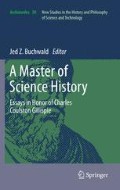Abstract
Classical mathematics is neither homogeneous nor all of one piece. Some chapters in its development go back as far as Greek mathematics. We have only to think, for example, of plane geometry, the geometry of cones or the geometry of spheres. Others are rooted in Arab mathematics, embracing the algebraic disciplines and work on geometrical transformations. Finally, yet other developments, such as infinitesimal calculus took place in Europe in the seventeenth century. What we can say without fear of contradiction, however, is that the distinctive characteristic of this classical mathematics is that it is ‘algebraic and analytical’. The question that remains is precisely when and how this distinctive characteristic saw the light of day, that is, how this algebraic-analytical reasoning arose and how it developed.
Access this chapter
Tax calculation will be finalised at checkout
Purchases are for personal use only
Notes
- 1.
By ‘founding act’ I do not in any sense mean a symbolic founding gesture or some manifestation of purely subjective significance, but a genuine project whose constituent elements show themselves progressively as the project itself is followed through.
- 2.
R. Rashed, Les Mathématiques infinitésimales du IX e au XI e siècle. Vol. I: Fondateurs et commentateurs: Banū Mūsā, Thābit ibn Qurra, Ibn Sinān, al-Khāzin, al-Qūhī, Ibn al-Sam \(\d{h} \), Ibn Hūd, London, al-Furqān Islamic Heritage Foundation, 1996, chap. I
- 3.
Ibid., chap. II.
- 4.
An edition of these treatises, with (French) translation and commentary is contained in R. Rashed and H. Bellosta, Ibrāhīm ibn Sinān. Logique et géométrie au X e siècle, Leiden, E.J. Brill, 2000.
- 5.
Edited with (French) translation and commentary in R. Rashed, Œuvre mathématique d’al-Sijzī. Vol. I: Géométrie des coniques et théorie des nombres au X e siècle, Les Cahiers du Mideo, 3, Louvain-Paris, Éditions Peeters, 2004.
- 6.
See R. Rashed, Geometry and Dioptrics in Classical Islam, London, al-Furqān, 2005, chap. V.
- 7.
Edited with (French) translation and commentary in R. Rashed, Œuvre mathématique d’al-Sijzī, vol. I.
- 8.
See R. Rashed, Geometry and Dioptrics in Classical Islam, chap. V.
- 9.
Les Catoptriciens grecs. I : Les miroirs ardents, edited with (French) translation and commentary by R. Rashed, Collection des Universités de France, published under the patronage of the Association Guillaume Budé, Paris, Les Belles Lettres, 2000.
- 10.
Les Mathématiques infinitésimales du IX e au XI e siècle, vol. III: Ibn al-Haytham. Théorie des coniques, constructions géométriques et géométrie pratique, London, al-Furqān, 2000.
- 11.
R. Rashed and Ch. Houzel, ‘Thābit ibn Qurra et la théorie des parallèles’, Arabic Sciences and Philosophy 15. 1, (2005), pp. 9–55, reprinted in R. Rashed (ed.), Thābit ibn Qurra. Science and Philosophy in Ninth-Century Baghdad, Scientia Graeco-Arabica, vol. 4, Berlin/New York, Walter de Gruyter, 2009.
- 12.
Les Mathématiques infinitésimales du IX e au XI e siècle, vol. II: Ibn al-Haytham, London, al-Furqān, 1993.
- 13.
An edition of this work with (French) translation and commentary is to be found in Les Mathématiques infinitésimales du IX e au XI e siècle, vol. I.
- 14.
R. Rashed and B. Vahabzadeh, Al-Khayyām mathématicien, Paris, Librairie Blanchard, 1999. English version : Omar Khayyam. The Mathematician, Persian Heritage Series n° 40, New York, Bibliotheca Persica Press, 2000 (without the Arabic texts).
- 15.
See Les Mathématiques infinitésimales du IX e au XI e siècle, vol. IV: Méthodes géométriques, transformations ponctuelles et philosophie des mathématiques, London, 2002.
Author information
Authors and Affiliations
Corresponding author
Editor information
Editors and Affiliations
Rights and permissions
Copyright information
© 2011 Springer Science+Business Media B.V.
About this chapter
Cite this chapter
Rashed, R. (2011). Founding Acts and Major Turning-Points in Arab Mathematics. In: Buchwald, J. (eds) A Master of Science History. Archimedes, vol 30. Springer, Dordrecht. https://doi.org/10.1007/978-94-007-2627-7_15
Download citation
DOI: https://doi.org/10.1007/978-94-007-2627-7_15
Published:
Publisher Name: Springer, Dordrecht
Print ISBN: 978-94-007-2626-0
Online ISBN: 978-94-007-2627-7
eBook Packages: Chemistry and Materials ScienceChemistry and Material Science (R0)

